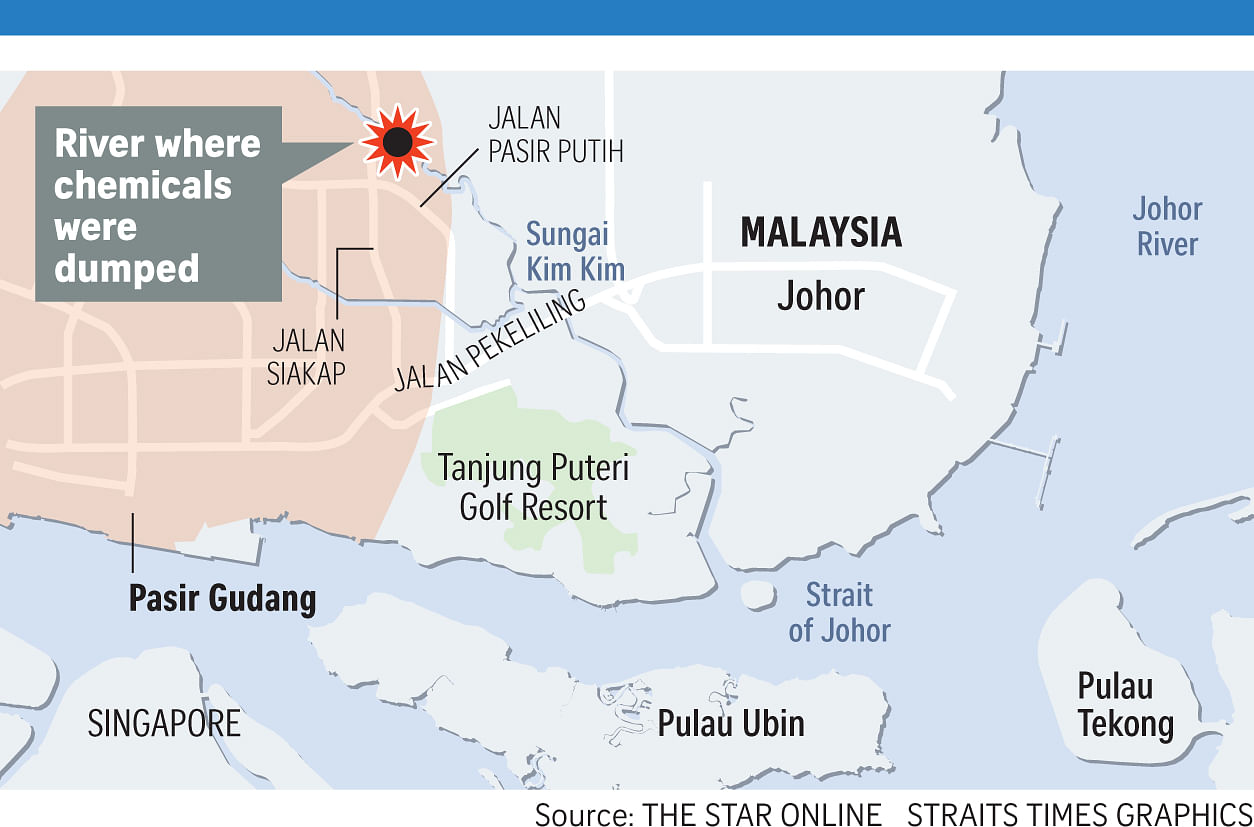SINGAPORE - The illegal dumping of toxic chemicals into a river in Pasir Gudang, Johor, has sickened more than 2,700 people, including hundreds of students.
Malaysia's Environment Minister Yeo Bee Yin said on Wednesday (March 13) that a number of chemicals have been ascertained from the samples taken.
They include benzene, acrolein, acrylonitrile, hydrogen chloride, methane, toluene, xylene, ethylbenzene and d-limonene.
What are these chemicals, where are they usually found, and what is their possible impact on humans?
1. Benzene
What: Benzene is a chemical that has a sweet, aromatic, gasoline-like smell. Most people can begin to smell benzene in the air at 1.5 to 4.7 parts per million, according to the United States Centers for Disease Control and Prevention (CDC).
Where: Benzene can be found in crude oil, gasoline and cigarette smoke. It is also used to make some types of lubricants, rubbers, dyes and pesticides.
Impact: The International Agency for Research on Cancer has classified benzene as carcinogenic to humans. Human exposure to benzene has been associated with a range of acute and long-term adverse health effects and diseases, including narcosis - in which a person blacks out - and aplastic anaemia - which results in a drop in blood cell count - according to the World Health Organization.
Some symptoms of prolonged benzene exposure include headaches, dizziness, drowsiness, confusion, tremors and loss of consciousness.
2. Acrolein
What: Acrolein is a clear, colourless, or yellow liquid with a pungent, suffocating odour.
Where: The chemical has been used to control plant and algae growth in irrigation canals. It has also been used to manufacture other chemicals, as a warning agent in gases, as a test gas for gas masks, in military poison gases, for making colloidal metals, in leather tanning, and as a fixative in histology.
Impact: Inhaled acrolein is highly toxic and is irritating to the upper respiratory tract even at low concentrations, according to the US Agency for Toxic Substances and Disease Registry (ATSDR). Acrolein is severely irritating to the skin and eyes.
3. Acrylonitrile
What: Acrylonitrile is a colourless, liquid, man-made chemical with a sharp, onion- or garlic-like odour.
Where: Acrylonitrile is used mostly to make plastics, acrylic fibres, and synthetic rubber. As acrylonitrile evaporates quickly, it is most likely to be found in the air around chemical plants where it is made, according to the ATSDR.
Impact: Exposure to large amounts of the chemical affects mainly the nervous system. Symptoms can include headaches and nausea, while exposure to higher concentrations may temporarily damage red blood cells and the liver.
Long-term exposure to acrylonitrile may increase the chances of getting cancer, according to the US Department of Health and Human Services.
4. Hydrogen chloride
What: Hydrogen chloride has a strong irritating smell. The chemical's colour ranges from colourless to slightly yellow. Hydrogen chloride vapour is corrosive.
Where: It can be formed during the burning of many types of plastic. The chemical has many uses, including for cleaning, pickling, electroplating metals and tanning leather. The chemical exists naturally as liquid hydrochloric acid in the stomach to aid with digestion.
Impact: Hydrogen chloride gas is intensely irritating to the mucous membranes of the nose, throat, and respiratory tract. Exposure to high concentrations can rapidly lead to swelling and spasm of the throat and suffocation, according to the ATSDR.
5. Methane
What: Methane is a colourless, odourless and highly flammable gas.
Where: Methane is a primary component of natural gas, and natural sources of it include bodies of water, wildfires and digestive processes of animals.
Impact: There are no serious health effects from long-term exposure to methane. It is only harmful if the concentration is so high that it displaces oxygen in the air, which could lead to symptoms such as rapid breathing and a rapid heart rate.
6. Toluene
What: Toluene is a clear, colourless liquid with a distinctive smell.
Where: It occurs naturally in crude oil and in the tolu tree. Toluene is also produced in the process of making gasoline and other fuels from crude oil. The chemical is used in making paints, paint thinners, fingernail polish, lacquers, adhesives, and rubber and in some printing and leather tanning processes.
Impact: Symptoms of repeated exposure include headaches, sleepiness, and an impairment in ability to think clearly.
Low to moderate, day-after-day exposure to toluene can cause tiredness, confusion, weakness, drunken-type actions, memory loss, nausea, and loss of appetite, according to the ATSDR.
7. Xylene
What: Commercial grade xylene is a clear, colourless liquid with a sweet, aromatic odour.
Where: It is mostly obtained from crude petroleum. Xylene is widely used as a thinner and solvent in paints, inks, adhesives, and other products, and also as a solvent in pesticide products.
Impact: Xylene irritates the skin, eyes, and respiratory tract. Acute exposure to its vapour may irritate the mucous membranes of the respiratory tract.
Symptoms of xylene poisoning include central nervous system effects like headaches, dizziness, and drowsiness.
8. Ethylbenzene
What: Ethylbenzene is a colourless liquid that smells like gasoline.
Where: It is found naturally in oil, and is also used in fuels. Products like gasoline, paints, pesticides, carpet glue, varnishes, and automobile products contain ethylbenzene.
Impact: Exposure to high levels of ethylbenzene in the air for short periods can cause eye and throat irritation. Exposure to higher levels can result in vertigo and dizziness.
9. D-limonene
What: D-limonene is a colourless liquid or oil with a pleasant lemon-like smell.
Where: The chemical is widely used as a flavour or fragrance additive in cosmetics, food, and industrial solvents. It is a major constituent in citrus oils such as orange, lemon and grapefruit.
In the Pasir Gudang incident, the d-limonene is from the recycling of tyres, said Ms Yeo.
Impact: D-limonene is considered to have fairly low toxicity. Studies involving humans demonstrated low toxicity of d-limonene after single and repeated doses for up to a year.

Sources: United States Centers for Disease Control and Prevention, United States Agency for Toxic Substances and Disease Registry, World Health Organization, Canadian Centre for Occupational Health and Safety, Toxicology Data Network


